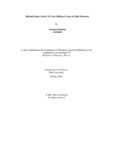| dc.contributor.advisor | Sharmin, Shahana | |
| dc.contributor.author | Rahman, Farhana | |
| dc.date.accessioned | 2024-01-25T04:53:25Z | |
| dc.date.available | 2024-01-25T04:53:25Z | |
| dc.date.copyright | 2022 | |
| dc.date.issued | 2022-10 | |
| dc.identifier.other | ID 16346040 | |
| dc.identifier.uri | http://hdl.handle.net/10361/22195 | |
| dc.description | This thesis is submitted in partial fulfillment of the requirements for the degree of Bachelor of Pharmacy, 2022. | en_US |
| dc.description | Cataloged from PDF version of thesis. | |
| dc.description | Includes bibliographical references (pages 34-35). | |
| dc.description.abstract | Herbal remedies are typically used to prevent illness and treat persistent health issues rather than emergencies. Herbal therapy for skin problems has been used for thousands of years. However, its use grows when conventional Medicine is inadequate in treating diseases such as advanced cancer and emerging infectious infections. The giant apes, who are genetically quite close to us, also employ herbs for treating illness. Since different regions had access to different plants, different herbal treatments emerged and were traded. Many regional herbal medicine systems have emerged around the globe, including in Europe, the Middle East, Africa, India, China, Japan, Australia, and the Americas. Herb combinations created as part of traditional Chinese Medicine (TCM) in China and the Ayurvedic herbs of India (Kapoor, 1990) are two renowned systems that are still in use today (Xu 2014). Purified extracts and synthetic chemical medications in popularity in Europe and the United States replaced plants. Herbal treatments and organic farming have both reentered popularity in recent years. This may be attributed partly to the growing awareness of the dangers of synthetic pharmaceuticals and the widespread trend toward a return to nature. To a lesser extent, patients and doctors are increasingly interested in using herbal therapies, including treatments for skin conditions. Herbal remedies that have been used for generations are the subject of rigorous scientific investigation in Asia, particularly in China and India. Herbal products and their intended applications in Germany are monitored by Commission E. (Blumenthal et al. 1998). Other than their use as food supplements, herbal products in the U.S. are not governed by any federal law at the present time. There are no regulations governing potency, quality, or dosage consistency. No rules are in place to control which herbs can be sold for which purposes. | en_US |
| dc.description.statementofresponsibility | Farhana Rahman | |
| dc.format.extent | 37 pages | |
| dc.language.iso | en | en_US |
| dc.publisher | Brac University | en_US |
| dc.rights | Brac University theses are protected by copyright. They may be viewed from this source for any purpose, but reproduction or distribution in any format is prohibited without written permission. | |
| dc.subject | Skin | en_US |
| dc.subject | Diseases | en_US |
| dc.subject | Herbal drugs | en_US |
| dc.subject | Plant | en_US |
| dc.subject | Human body | en_US |
| dc.subject | Inflammation | en_US |
| dc.subject.lcsh | Medicine, Ayurvedic | |
| dc.subject.lcsh | Medicinal plants | |
| dc.title | Herbal drugs used in to cure different types of skin disorders | en_US |
| dc.type | Thesis | en_US |
| dc.contributor.department | School of Pharmacy, Brac University | |
| dc.description.degree | B. Pharmacy | |

